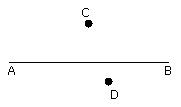To a given infinite straight line, from a given point which is not on it, to draw a perpendicular straight line
 Let AB be the given infinite straight line, and C the given point
which is not on it; thus it is required to draw to the given
infinite straight line AB, from the given point C which is not on it,
a perpendicular straight line.
Let AB be the given infinite straight line, and C the given point
which is not on it; thus it is required to draw to the given
infinite straight line AB, from the given point C which is not on it,
a perpendicular straight line.
 For let a point D be taken at random on the other side of the straight
line AB,
For let a point D be taken at random on the other side of the straight
line AB,
 and with centre C and distance CD let the circle EFG be described;
and with centre C and distance CD let the circle EFG be described;
 let the straight line EG be bisected at H,
let the straight line EG be bisected at H,

 and let the straight lines CG, CH, CE be joined.
and let the straight lines CG, CH, CE be joined.
 I say that CH has been drawn perpendicular to the given infinite
straight line AB from the given point C which is not on it.
I say that CH has been drawn perpendicular to the given infinite
straight line AB from the given point C which is not on it.
 For, since GH is equal to HE, and HC is common,
the two sides GH, HC are equal to the two sides EH, HC respectively;
For, since GH is equal to HE, and HC is common,
the two sides GH, HC are equal to the two sides EH, HC respectively;
 and the base CG is equal to the base CE;
and the base CG is equal to the base CE;
Therefore the angle GHC is equal to the angle EHC.
 And they are adjacent angles.
But, when a straight line set up on a straight line makes the
adjacent angles equal to one another, each of the equal angles is
right, and the straight line standing on the other is called a
perpendicular to that on which it stands.
And they are adjacent angles.
But, when a straight line set up on a straight line makes the
adjacent angles equal to one another, each of the equal angles is
right, and the straight line standing on the other is called a
perpendicular to that on which it stands.
 Therefore CH has been drawn perpendicular to the given infinite
straight line AB from the given point C which is not on it.
Therefore CH has been drawn perpendicular to the given infinite
straight line AB from the given point C which is not on it.
Q.E.F.
We now concatenate the constructions.
1. Draw circle at C large enough.
 Bisect GE.
Bisect GE.
Note: Two circles of equal distance, GE, and one of smaller distance, CE = CG.